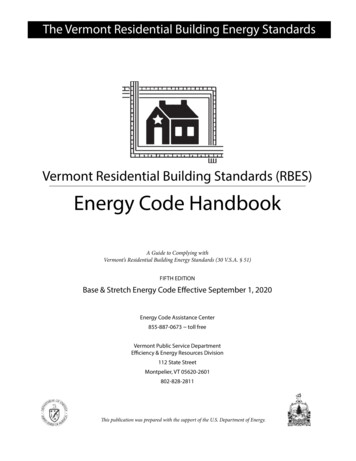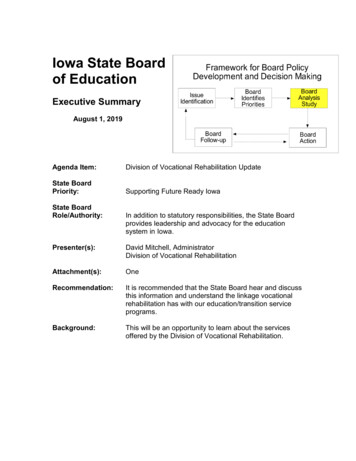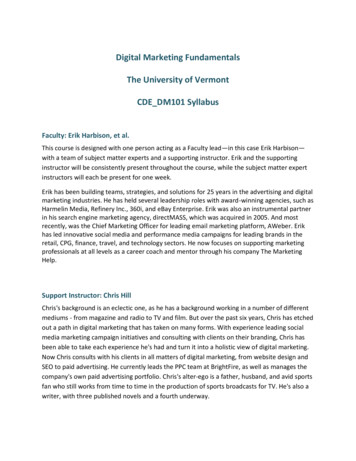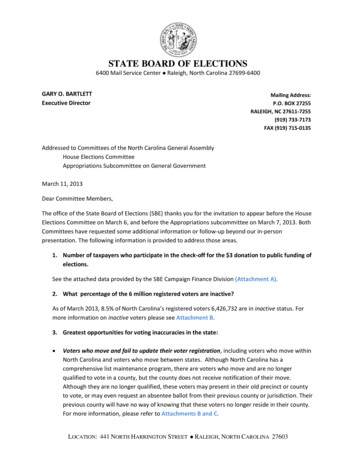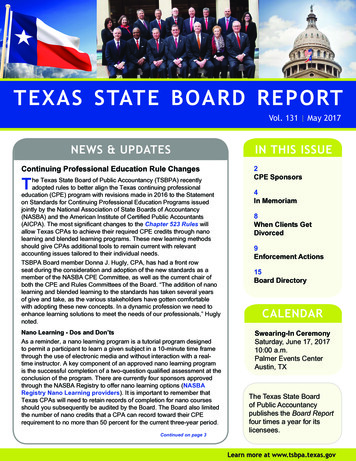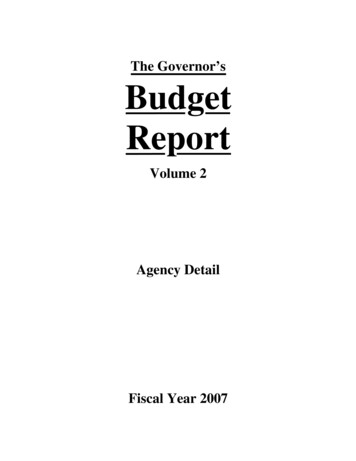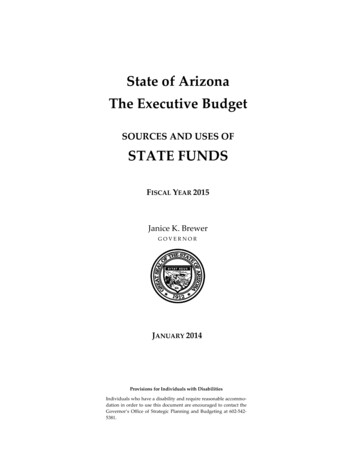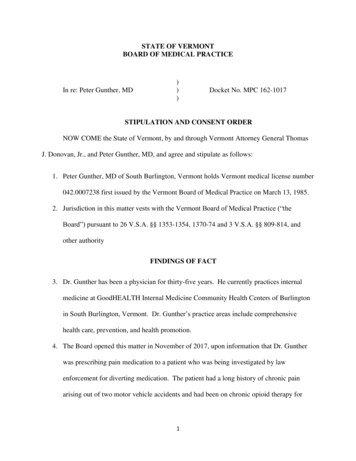
Transcription
STATE OF VERMONTBOARD OF MEDICAL PRACTICEIn re: Peter Gunther, MD)))Docket No. MPC 162-1017STIPULATION AND CONSENT ORDERNOW COME the State of Vermont, by and through Vermont Attorney General ThomasJ. Donovan, Jr., and Peter Gunther, MD, and agree and stipulate as follows:1. Peter Gunther, MD of South Burlington, Vermont holds Vermont medical license number042.0007238 first issued by the Vermont Board of Medical Practice on March 13, 1985.2. Jurisdiction in this matter vests with the Vermont Board of Medical Practice (“theBoard”) pursuant to 26 V.S.A. §§ 1353-1354, 1370-74 and 3 V.S.A. §§ 809-814, andother authorityFINDINGS OF FACT3. Dr. Gunther has been a physician for thirty-five years. He currently practices internalmedicine at GoodHEALTH Internal Medicine Community Health Centers of Burlingtonin South Burlington, Vermont. Dr. Gunther’s practice areas include comprehensivehealth care, prevention, and health promotion.4. The Board opened this matter in November of 2017, upon information that Dr. Guntherwas prescribing pain medication to a patient who was being investigated by lawenforcement for diverting medication. The patient had a long history of chronic painarising out of two motor vehicle accidents and had been on chronic opioid therapy for1
years. The matter was assigned to the Central Investigative Committee of the Board(“Committee”).5. The Committee’s investigation included identification of several patients who receivedprescriptions for greater quantities of controlled substances than expected and thoroughanalysis of the medical records for those patients obtained from Dr. Gunther’s practice.All five of these patients, hereafter designated as Patients 1-5, were treated by Dr.Gunther for chronic pain, among other chronic conditions. The Committee initially notedthat Dr. Gunther did not conduct physical examinations of the body parts correspondingto the reports of chronic pain for these five patients.6. Dr. Gunther has treated Patient 1 for multiple years for numerous medical issuesincluding Patient 1’s complaints of chronic pain due to a back injury. Dr. Guntherprescribed Patient 1 large quantities of opioid medication, which in December 2014totaled 21 pills of oxycodone a day at a morphine milligram equivalent (“MME”) of 710.7. Dr. Gunther prescribed early refills for Patient 1 for multiple reasons including overseastravel, and escalating dosages of opioids without instituting safety measures such as urinedrug screens or pill counts. Dr. Gunther repeatedly asked Patient 1 to undergo imaging,but an MRI was not performed until June 2018. That MRI confirmed L4-5 severebilateral foraminal stenosis.8. Dr. Gunther did not follow Vermont Department of Health (“VDH”) Rules governingopioid treatment for Patient 1 by not documenting annual copies of controlled substancecontracts in Patient 1’s medical records for the years 2015 and 2016.9. Dr. Gunther prescribed Patient 1 oxycodone at 150 MME from July 2017 throughFebruary 2018. During this period he did not prescribe Narcan to Patient 1 despite the2
requirement in the Vermont Department of Health Rule Governing the Prescribing ofOpioids for Pain, effective on July 1, 2017, that all patients prescribed opioids atquantities greater than 90 MME receive this prescription.10. Dr. Gunther prescribed opioids to Patient 2 to treat chronic pain. Prior to September2016, Dr. Gunther prescribed an MME of 585 for this patient, and as recently asSeptember 2020 was prescribing an MME of 450.11. Dr. Gunther did not wean down Patient 2’s medication when Patient 2 reported takingless than the prescribed dose, institute pill counts, or document discussions with Patient 2about what was happening to the extra medication.12. Dr. Gunther only conducted urinalysis testing for Patient 2 on two occasions: once in2013 and again in 2014. The results of both tests did not correspond with the medicationprescribed to Patient 2. Notwithstanding these aberrant results, Dr. Gunther did notdocument any discussions with Patient 2 about why prescribed fentanyl andbenzodiazepine were not in Patient 2’s urine or make changes to his prescription practicefor this patient.13. Dr. Gunther did not comply with VDH opioid prescription rules for Patient 2 as he didnot include annual copies of controlled substance contracts in Patient 2’s medical recordsfor the years 2015, 2016 or 2017.14. Dr. Gunther did not prescribe Narcan for Patient 2. Patient 2 was prescribed an opioidand a benzodiazepine with an MME in excess of 90 MME. The Vermont Department ofHealth Rule Governing the Prescribing of Opioids for Pain, effective on July 1, 2017mandated a Narcan prescription given both this polypharmacy and the patient’s MME.3
15. Dr. Gunther treated Patient 3 with a high dosage of opioids. Patient 3 had numerousconcurrent medical problems, including insulin dependent diabetes, liver transplant,hypertension, depression, and avascular necrosis of his hip. Dr. Gunther’s opioidprescriptions for Patient 3 was 780 MME from August 2016 to January 2017, at whichtime Patient 3 was admitted to inpatient treatment for detoxification related to alcoholand opioid abuse.16. Between July 20, 2016 and January 2017, Dr. Gunther increased Patient 3’s painmedication dosing by adding a fentanyl patch, although there is no record that Dr.Gunther saw Patient 3 in person during this time. Telephone records show calls betweenthe patient and Dr. Gunther’s office during that time period, but there is no recordshowing discussions with Dr. Gunther about chronic pain management during any call.17. Dr. Gunther documented a urinalysis test for Patient 3 in 2013 that was positive fornonprescribed opioids but did not document any discussion of the aberrant results.18. Dr. Gunther prescribed Patient 3 alprazolam without documenting this prescription in thepatient’s medical record. He also prescribed Adderall for Patient 3 withoutdocumentation in the patient’s record of the medication’s effectiveness, side effects, anduse.19. Patient 4 was prescribed a complex polypharmacy including controlled substances, whichin January 2018 constituted 37-45 pills a day including as-needed medications. Many ofthese medications were prescribed at high dosages. Dr. Gunther did not document howhe planned to manage or reduce the interactions between the multitude of prescribedmedications.4
20. In November 2017, Patient 4 reported to Dr. Gunther taking less than the dose ofoxycodone which Dr. Gunther had prescribed. Dr. Gunther did not reduce Patient 4’sprescription of oxycodone until May 2018, then stopped the prescription a month laterwithout adequate documentation of his clinical decision making in the patient’s medicalrecord. Patient 4 has been off all opioids since approximately June 2018.21. Dr. Gunther did not include an annual copy of a controlled substance contract in Patient4’s records from 2015 to 2016 as required by the Vermont Department of Health Rule.22. Dr. Gunther treated Patient 5, who had a substance abuse history, for chronic pain, amongother conditions. He prescribed Patient 5 an MME of 780 from 2014 to 2017 as well as abenzodiazepine, without adequately documenting the rationale or safety of this course oftreatment.23. Dr. Gunther did not keep accurate prescription records for Patient 5, including correctmedication names and prescribed dosages. He did not record refills of Patient 5’s opioidor benzodiazepine prescriptions in this patient’s medical record for a period of over ayear from April 24, 2013 – April 30, 2014.24. Dr. Gunther prescribed tramadol, clonazepam and zolpidem for Patient 5 during a gap inoffice visits from August 2014 - January 2015, and prescribed the controlled substanceslorazepam, clonazepam and zolpidem and the opioids oxycodone and OxyContin duringanother gap in office visits from January – October 2017. The latter gap in office visitsoccurred two months after a November 2016 office visit at which Patient 5 reported toDr. Gunther that she had been consuming alcohol and using heroin.25. Dr. Gunther prescribed Patient 5 the opioids OxyContin and oxycodone-acetaminophenas well as the benzodiazepines clonazepam (for restless leg syndrome) and lorazepam5
(for anxiety) from July 2017 through July 2018. During this period he did not prescribeNarcan to Patient 5 despite the requirement in the Vermont Department of Health RuleGoverning the Prescribing of Opioids for Pain, effective on July 1, 2017, that he do so forpatients prescribed a combination of an opioid and a benzodiazepine.26. After the initiation of the Board’s investigation in this matter, Dr. Gunther made practiceimprovements including the following:a. Dr. Gunther included the required contracts and consent forms for Patient 1 in 2017and 2018.b. In January 2018, he also began to wean this patient’s Oxycodone and by December2019 weaned the dosage from 12 pills per day to 4 per day, a reduction from 180 to 80MME’s.c. Dr. Gunther began to wean Patient 2 from fentanyl after a negative urine drug screenon February 8, 2019. Patient 2 was fully weaned from fentanyl on March 6, 2019,however, he continues to prescribe Patient 2 Oxycodone at an MME of 450.d. Contracts and informed consents were signed for Patient 2 in 2018 and 2019.e. Patient 3 has been off all narcotics since the early spring of 2019.27. In addition, Dr. Gunther has provided two comprehensive letters to the Committeeoutlining the changes he has made to his practice. Those changes include thedevelopment of a written template for all patients with chronic pain on opioidmedications that follows the requirements in the VDH Rule Governing the Prescribing ofOpioids for Pain. Dr. Gunther has conferred with three subject matter experts on hismanagement of patients who are prescribed opioid medications for chronic pain, one ofwhom is double boarded in Addictive Medicine and Family Medicine. Dr. Gunther has6
met regularly with the double boarded physician to review his charts for the past sixteenmonths. These conferrals have focused on Dr. Gunther’s adherence to opioid prescribingprotocols. Dr. Gunther completed an intensive American Society of Addiction Medicine(ASAM) electronic learning CME approved course, as well as a course on usingelectronic health records to improve his practice.CONCLUSIONS OF LAW28. The Board may find “that failure to practice competently by reason of any cause on asingle occasion or on multiple occasions constitutes unprofessional conduct.” 26 V.S.A. §1354(b). “Failure to practice competently includes, as determined by the board (1)performance of unsafe or unacceptable patient care; or (2) failure to conform to theessential standards of acceptable and prevailing practice.” 26 V.S.A. § 1354(b)(1) and(2).29. Dr. Gunther acknowledges that if this matter were to proceed to a contested hearing, theState could prove that he did not conform to the essential standards of acceptable andprevailing practice by:a.not regularly conducting and documenting physical examinations correspondingto the areas of chronic pain for the five patients whose files were reviewed by theCommittee.b.not regularly implementing adequate safety protections to monitor for opioidmedication diversion such as pill counts or frequent urinalysis testing.7
c. not sufficiently documenting aberrant test results and the response thereto whenthose tests were administered and yielded results inconsistent with the patient’sprescribed medications.d. prescribing high dosages of opioids for two patients during lengthy gaps in officevisits.e. not maintaining adequate patient medical records for three patients includingdocumenting all prescribed medication, medication dosages, and refills in thepatient record.30. The Board may find that “failure to comply with provisions of State statutes or rulesgoverning the practice of medicine or surgery” constitutes unprofessional conduct. 26V.S.A. § 1354(a)(27).31. Section 6.1.1 of the Vermont Department of Health’s Rule Governing the Prescribing ofOpioids for Pain mandates that a prescriber shall “conduct and document a thoroughmedical evaluation and physical examination as part of the patient’s medical record whenprescribing opioids for chronic pain.”132. Prescribers are also required by the VDH Opioid Rule 6.2.2.1 to schedule and undertakeperiodic follow-up with patients receiving treatment for chronic pain with opioids. Thisfrequency should be determined by the patient’s risk factors, medication dose, and otherclinical indicators, however, the Rule warns that “[p]atients who are stable in terms of the1Unless otherwise noted, references to the Vermont Department of Health Rules Governing the Prescribing ofOpioids for Pain refer to the rules effective July 1, 2017. Provisions such as this one, which were also present in theprior version of the Rule effective August 1, 2015, will be so noted. See Section 4.1 of the Rule Governing thePrescribing of Opioids for Chronic Pain effective August 1, 2015.8
medication dose and its effectiveness in managing chronic pain must be reevaluated noless than once every 90 days ”233. Prescribers are also responsible for ensuring that their chronic pain patients complete andsign a Controlled Substance Treatment Agreement which is reviewed between theprescriber and patient no less frequently than annually, and that the initial agreement andthese reviews are documented in the patient’s medical record. See VDH OpioidPrescribing Rule §§ 6.2.1.5 and 6.4.1334. Section 7.1 of the VDH Opioid Rule mandates that prescribers co-prescribe naloxone(Narcan) for all patients who receive opioid prescriptions exceeding 90 MME. Per § 7.2,Prescribers are also mandated to prescribe naloxone for patients prescribed opioids and aconcurrent benzodiazepine prescription.35. Dr. Gunther acknowledges that if this matter were to proceed to a contested hearing, theState could prove that he did not follow all of the applicable Opioid Prescription Rules,constituting non-compliance with Vermont state statutes and rules of practice.36. Consistent with Dr. Gunther’s cooperation with the Board, he acknowledges that if theState were to file charges it could satisfy its burden at a hearing and a finding adverse tohim could be entered by the Board, pursuant to 26 V.S.A. §§ 1354(a)(22), 1354(a)(27)and § 1354(b)(1) and (2).2This provision reflects an amendment to the August 1, 2015 Rule Section 5.3.3 which mandated reevaluation forchronic pain patients who were stable in terms of their medication dose annually.3The 2015 VDH Rule Governing the Prescribing of Opioids for Pain §§ 5.3, 5.3.2, required that a ControlledSubstance Treatment Agreement needed to be included in the patient’s medical record for all patients prescribedopioids for 90 days or more for chronic pain. Section 7.1 of the Rule mandated review of this Agreement betweenthe provider and patient at least annually with this review documented in the patient record. Per § 8.1.6 of the 2015Rule, patients receiving extended release oxycodones or hydrocodones not manufactured as abuse deterrent opioidsmust have a documented Controlled Substance Agreement which included urine testing at a frequency determinedby the patient’s risk assessment and ongoing behavior but no less frequently than annually.9
37. Dr. Gunther agrees that the Board adopts and incorporates as its facts and/or conclusionsin this matter Paragraphs 1 through 36 above, and further agrees that this is an adequatebasis for the Board actions set forth herein. Any representation by Dr. Gunther herein ismade solely for the purposes set forth in this agreement.38. Therefore, in the interest of Dr. Gunther’s desire to fully and finally resolve the matterpresently before the Board, he has determined that he shall enter into this agreement withthe Board. Dr. Gunther enters no further admissions here, but to resolve this matterwithout further time, expense and uncertainty; he has concluded that this agreement isacceptable and in the best interest of the parties.39. Dr. Gunther agrees and understands that by executing this document he is waiving anyright to challenge the jurisdiction and continuing jurisdiction of the Board in this matter,to be presented with a specification of charges and evidence, to cross-examine witnesses,and to offer evidence of his own to contest any allegations by the State.40. The parties agree that upon their execution of this Stipulation and Consent Order, andpursuant to the terms herein, the above-captioned matter shall be resolved by the Board.Thereafter, the Board will take no further action as to this matter absent non-compliancewith the terms and conditions of this document by Dr. Gunther.41. This Stipulation and Consent Order is conditioned upon its acceptance by the VermontBoard of Medical Practice. If the Board rejects any part of this document, the entireagreement shall be considered void. Dr. Gunther agrees that if the Board does not acceptthis agreement in its current form, he shall not assert in any subsequent proceeding anyclaim of prejudice from any such prior consideration. If the Board rejects any part of thisagreement, none of its terms shall bind Dr. Gunther or constitute an admission of any of10
the facts of the alleged misconduct, it shall not be used against Dr. Gunther in any way,and it shall be kept in strict confidence. And it shall be without prejudice to any futuredisciplinary proceeding and the Board’s final determination of any charge against Dr.Gunther.42. Dr. Gunther acknowledges and understands that this Stipulation and Consent Order shallbe a matter of public record, shall be entered in his permanent Board file, shall constitutean enforceable legal agreement, and may and shall be reported to other licensingauthorities, including but not limited to: the Federation of State Medical Boards BoardAction Databank and the National Practitioner Data Bank. In exchange for the actions bythe Board, as set forth herein, Dr. Gunther expressly agrees to be bound by all terms andconditions of this Stipulation and Consent Order.43. The parties therefore jointly agree that should the terms and conditions of this Stipulationand Consent Order be deemed acceptable by the Board, it may enter an orderimplementing the terms and conditions herein.ORDERWHEREFORE, based on the foregoing and the consent of Dr. Gunther, it is herebyORDERED that:1. Dr. Gunther’s medical license shall be CONDITIONED as follows:a. Dr. Gunther shall successfully complete AMA PRA Category 1 continuingmedical education (“CME”) courses on the following topics: controlled substancepain management, and medical recordkeeping. Each CME course must becompleted no later than one (1) year after this Stipulation is approved by the11
Board. Dr. Gunther shall seek prior approval, in writing, from the Committee foreach CME course. These courses must be live in-person or live interactivecourses offered remotely. Upon successful completion of each CME course, heshall provide the Committee with proof of attendance. Dr. Gunther shall alsoprovide the Committee with a brief written narrative of each CME course whichwill document what he learned from each course, and how he will apply thatknowledge to his practice. Dr. Gunther shall provide proof of attendance and thewritten narrative to the Committee. Dr. Gunther shall be solely responsible for allcosts associated with meeting these CME requirements.b. Dr. Gunther shall provide a letter to the Committee outlining the changes he madein his treatment of chronic opioid pain management cases to address the identifiedpractice concerns within sixty (60) days of the Board’s approval of this order.c.Dr. Gunther shall have a “practice monitor,” for three (3) years subject tothe terms and conditions set forth in the attached Practice MonitoringAgreement (“Agreement”), which is incorporated by reference and attachedhereto as Exhibit A. The practice monitoring requirement will not beginuntil the official “start date” as defined in the attached Agreement. Dr.Gunther shall comply with the terms and obligations of the Agreement. Dr.Gunther shall provide a copy of this Stipulation and Consent Order to thepractice monitor. Dr. Gunther shall be responsible for ensuring that thepractice monitor complies with the terms and obligations of the Agreement.The practice monitoring requirement will not cease until the Committee hasapproved, in writing, Dr. Gunther’s request to end the monitoring. Dr.12
Gunther may apply to the Committee for relief from the practice monitoringcondition if he is no longer prescribing controlled substances or if he is nolonger practicing primary care internal medicine. The decision whether togrant or deny the requested relief shall be solely within the discretion of theCommittee. The practice monitoring requirement will not cease until theCommittee has approved, in writing, Dr. Gunther’s request to end themonitoring.d. Dr. Gunther shall pay a 5,000 administrative penalty consistent with 26 V.S.A. §1374(b)(2)(A)(iii). Payment shall be made to the “State of Vermont Board ofMedical Practice,” and shall be sent to the Vermont Board of Medical Practiceoffice, at the following address: David Herlihy, Executive Director, VermontBoard of Medical Practice, P.O. Box 70, Burlington VT 05402-0070. Paymentshall be due no later than one (1) month after this Stipulation and Consent Orderis approved by the Board.13
PRACTICE MONITORING AGREEMENTVermont Board of Medical PracticePeter Gunther, M.D.Docket No. MPC 162-10171. Pursuant to a Stipulation and Consent Order entered into by Peter Gunther, M.D.(“Dr. Gunther”) and the Vermont Board of Medical Practice (“the Board”) in DocketNo. MPC 162-1017, Dr. Gunther has agreed to retain a practice monitor to monitorhis treatment of patients with chronic pain. The purpose of this Practice MonitoringAgreement (“Agreement”) is to set forth the terms of the practice monitoringcomponent of Dr. Gunther’s Stipulation and Consent Order (attached andincorporated by reference). This Agreement will be signed by Dr. Gunther and thepractice monitor approved by the Central Investigative Committee (“theCommittee”).2. Dr. Gunther is responsible for selecting a practice monitor.3. The practice monitor chosen by Dr. Gunther shall be a Vermont licensed physicianwith an unconditioned license who has experience in the treatment of chronic painwith opioids, ideally in a primary care/internal medicine practice setting.4. Dr. Gunther shall obtain approval from the Committee for his choice of practicemonitor. Dr. Gunther shall submit in writing to the Committee the practice monitor’sname, contact information, and curriculum vitae. The Committee retains discretion toapprove or disapprove the choice of practice monitor for any reason. The Committeeshall communicate in writing its decision to Dr. Gunther. If the proposed practicemonitor is not approved, Dr. Gunther remains responsible for using the procedure
outlined in this paragraph to submit his choice of another proposed practice monitorfor Committee consideration.5. The Board shall not bear any of the costs associated with the practice monitor.6. Dr. Gunther shall provide the practice monitor with a copy of the fully executedStipulation and Consent Order.7. The practice monitoring shall start within sixty (60) days of the date that the Boardapproves the Stipulation and Consent Order (hereinafter referred to as the “startdate”).8. The practice monitor will follow all state and federal health privacy regulations andstatutes, including, but not limited to, HIPAA, and will review and sign any necessaryHIPAA authorizations, business associate agreements, or any other requireddocuments to enable access to, and review of, patient protected health information.9. The practice monitor shall perform a record review every sixty (60) days of ten (10)of Dr. Gunther’s patients who are receiving opioid medications for chronic painunless there are fewer than ten patients, in which case it shall be a total of tenincluding patients who are prescribed other controlled substances. The practicemonitor shall select the patients whose records are to be reviewed. If during any sixty(60) day period Dr. Gunther has no patients receiving controlled substances, thepractice monitor shall notify the Committee in writing, and the practice monitoringrequirements shall be suspended until Dr. Gunther notifies the Committee that he isagain prescribing controlled substances.10. The practice monitor may review any other documents, records, files, logs, etc. forinformation needed to prepare written monitoring reports.
11. The practice monitor may speak with Dr. Gunther’s co-workers to obtain informationneeded to prepare the written monitoring reports.12. The practice monitor shall meet with Dr. Gunther every sixty (60) days to discuss thefindings of his/her record review. Dr. Gunther is responsible for ensuring that there isappropriate documentation of each sixty (60) day record review and discussion. Suchdocumentation shall include the date of each record review, and the date and length oftime of each discussion between the practice monitor and Dr. Gunther regarding thefindings of each chart review. This documentation shall be submitted with each sixty(60) day practice monitoring report.13. The practice monitor shall report his/her findings in a detailed written report to theCommittee for three (3) full years excluding all periods in which practice monitoringis suspended because Dr. Gunther is not prescribing controlled substances. The firstreport shall be submitted no later than sixty (60) days after the practice monitoringagreement is signed.14. If at any time during the three-year practice monitoring period, Dr. Gunther is nolonger prescribing controlled substances or he is no longer practicing primary careinternal medicine, he may submit a written request to the Committee to end therequirement for monitoring. The practice monitoring requirement will not ceaseunless or until the Committee approves, in writing, Dr. Gunther’s request to end themonitoring.15. Dr. Gunther shall be responsible for ensuring that the following is reviewed by thepractice monitor and discussed and documented in the practice monitoring reports:
a. The number of chronic pain patients Dr. Gunther is currently treating withopioid medications;b. Documentation of each chart review performed by the practice monitorduring that review period including the findings of the chart review;c. Whether Dr Gunther’s prescribing of opioid medications meets thestandard of care and is in accordance with the current Vermont RuleGoverning the Prescribing of Opioids for Pain and the VermontPrescription Monitoring System Rule;d. Whether Dr. Gunther’s clinical monitoring of patients to whom he isprescribing opioid medications meets the standard of care;e. Whether Dr. Gunther’s medical recordkeeping is in accordance with thestandard of care;f. Whether Dr. Gunther’s general medical treatment meets the applicablestandard of care; andg. Any recommended improvements to Dr. Gunther’s practice. Althoughthe practice monitor will need to review patient charts to become familiarwith patient medical history, the focus of the practice monitoring will beimproving Dr. Gunther’s practice prospectively.16. Dr. Gunther shall be responsible for ensuring that the practice monitor’s reports aretimely submitted to the Committee, directed to the attention of the Vermont Board ofMedical Practice at the following address: P.O. Box 70, Burlington VT 05402-0070.17. After the Committee has received consecutive, favorable and timely sixty (60) daypractice monitoring reports for one (1) full year, Dr. Gunther may submit a written
request to the Committee to reduce the record reviews, and submission of practicemonitoring reports to occur on a quarterly basis.18. The practice monitoring shall continue for a total of three (3) years from the start dateand shall include three years of active monitoring, unless a modification to themonitoring requirement is approved by the Committee. Any time periods in whichDr. Gunther is not prescribing controlled substances shall not be counted toward thethree-year minimum. At the end of the monitoring period, Dr. Gunther shall submit awritten request to the Committee to end the requirement for monitoring. Such arequest shall not be considered by the Committee until Dr. Gunther has providedfavorable and timely monitoring reports for the monitoring period. The practicemonitoring requirement will not cease until the Committee has approved, in writing,Dr. Gunther’s request to end the monitoring.19. In the event that the practice monitor can no longer monitor Dr. Gunther’s practice,Dr. Gunther shall notify the Committee in writing within five (5) business days.Within thirty (30) days of providing notice to the Committee, Dr. Gunther shallsubmit the name of an additional proposed practice monitor which will be subject tothe approval process outlined in paragraph four.20. Upon notice to the Committee that the practice monitor can no longer serve, Dr.Gunther has sixty (60) days to obtain Committee approval for a new practice monitor.If a new practice monitor is not approved in that time, Dr. Gunther shall ceaseprescribing any opioid and/or benzodiazepine medications. Dr Gunther shall notresume prescribing opioid and/or benzodiazepine medications until a new practicemonitor is approved by the Committee and can begin monitoring his practice. The
Committee will endeavor to communicate their decision regarding the approval of anew proposed practice monitor to Dr. Gunther in writing within thirty (30) days ofwhen he submits the proposed monitor’s name, contact information, and curriculumvitae to the Committee. In the event that the Committee’s response is delayed beyondthirty (30) days, that additional response time will not count toward the 60-day limitthat Dr. Gunther has to find a new practice monitor or cease prescri
The Board opened this matter in November of 2017, upon information that Dr. Gunther . whom is double boarded in Addictive Medicine and Family Medicine. Dr. Gunther has . 7 met regularly with the double boarded physician to review his charts for the past sixteen months. These conferr
